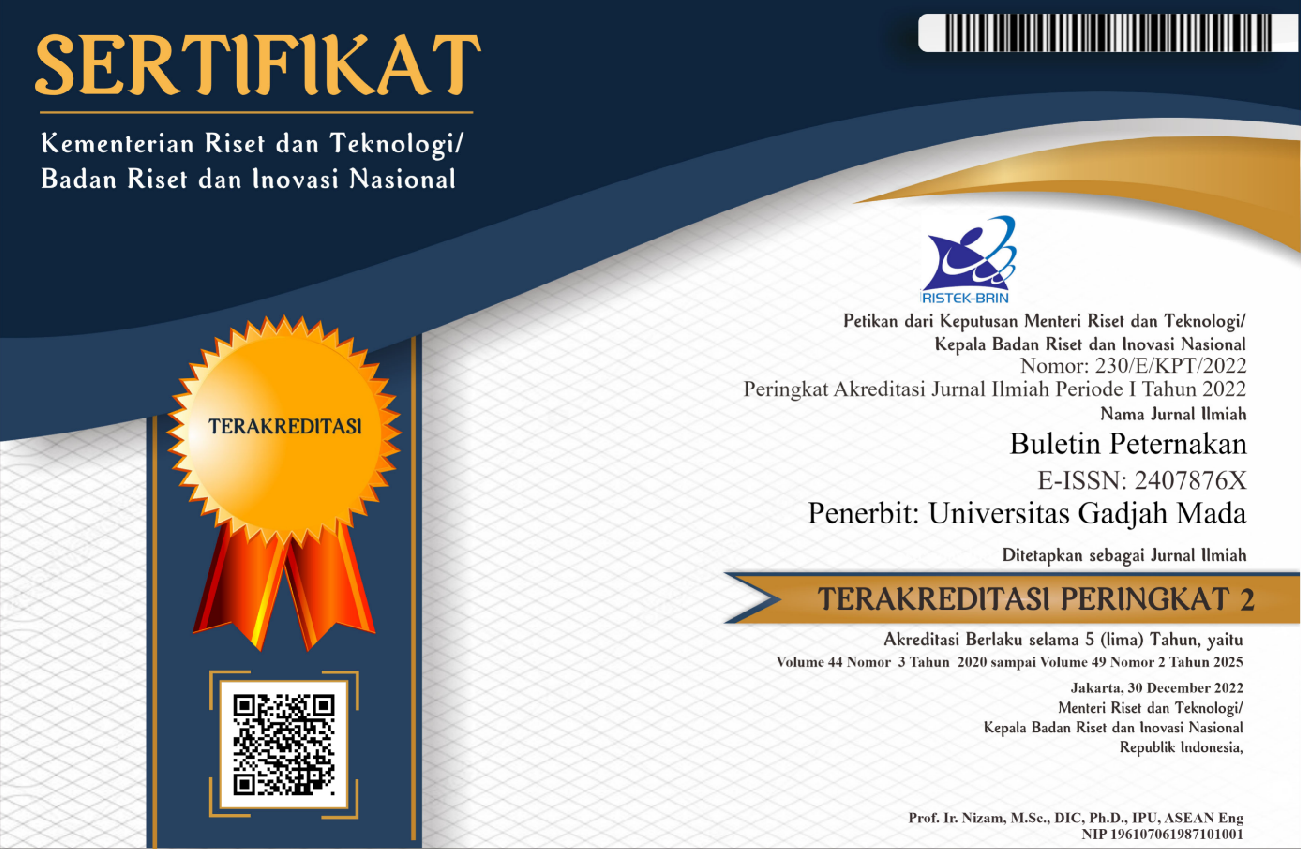Carrying Capacity Estimation of Herbicide-Treated and Untreated Palm Oil Plantation for Bali Cows
Eny Endrawati(1), Panjono Panjono(2), Bambang Suhartanto(3), Endang Baliarti(4*)
(1) Study Program of Animal Science, Faculty of Agriculture, Universitas Khairun, Maluku Utara, 97719, Indonesia
(2) Faculty of Animal Science, Universitas Gadjah Mada, Bulaksumur, Yogyakarta, 55281, Indonesia
(3) Faculty of Animal Science, Universitas Gadjah Mada, Bulaksumur, Yogyakarta, 55281, Indonesia
(4) Faculty of Animal Science, Universitas Gadjah Mada, Bulaksumur, Yogyakarta, 55281, Indonesia
(*) Corresponding Author
Abstract
This study aims to estimate the carrying capacity of oil palm plantations with the use of herbicides based on the forage availability for Bali cows. The research was performed in palm oil plantation owned by PTPN V Riau, from March 2016 until March 2017. The parameters observed were 1) Forage production that grows between palm trees at 6 weeks cutting age. The forage sample was taken from 5 point of 1x1m2, then subjected to proximate analysis. Data were analyzed with one-way random design, 2) Forage consumption; obtained by observation of 5 pregnant Bali cow and 7 non-pregnant for seven consecutive days 3). Estimated carrying capacity for Bali cows, obtained from the calculation of forage production (/ha/year) divided by forage consumption. The result of the research showed that 1). The production of dry matter (DM) forage in herbicide-treated areas was 689.55 kg/ha/year, not significantly different compared to untreated areas (622.33 kg/ha/year). Crude protein (CP) forage content of forage obtained from herbicide-treated area was significantly higher (p<0.05) than untreated area, whereas the total content of DM and total digestible nutrients (TDN) was not significantly different. DM consumption of pregnant Bali cow was on average 3.68±0.29 kg/head/day or 1,343.20±105.85 kg/head/year and non-pregnant 4.02±0.36 kg/head/day or 1,467.30±131.4 kg/head/year. The estimated carrying capacity on herbicide-treated (0.51 head of pregnant cow/ha), did not show any significant difference compared to untreated area (0.46 head/ha). For non-pregnant, the carrying capacity of herbicide-treated area (0.47 head/ha) was not different with non-treated area (0.42 head/ha). It was concluded that the use of herbicide on palm oil plantation had no effect on the carrying capacity of the Bali cow.
Keywords
Full Text:
PDFReferences
Abdullah, L. 2006. The development of integrated forage production system for ruminants in rainy tropical region. Bull. Facul. Agric. Niigata Univ. 58: 125-128.
Adriadi, A., Chairul, and Solfiyeni. 2012. Analisis vegetasi gulma pada perkebunan kelapa sawit (Elais quineensis jacq) di Kilangan, Muaro Bulian, Batang Hari. Jurnal Biologi Universitas Andalas 1: 108-115.
Anggraeny, Y. N. and U. Umiyasih. 2010. Tinjauan tentang kecukupan nutrisi dan dukungan teknologi peningkatan kualitas pakan pada usaha pembibitan sapi potong rakyat. Seminar Nasional. Hari Pangan Sedunia XXVII. Loka Penelitian Sapi Potong Grati. Jawa Barat.
AOAC. 2005. Offical Methods of Analysis. Association of Official Analytical Chemists. 18th edn. W. Horwitz and G. W. Latimer, Jr. (ed). Published by AOAC International, USA.
Chin, F. Y. 1998. Sustainable use of ground vegetation under mature oil palm and rubber trees for commercial beef production. In: Basic Animal Nutrition and Feeding. A. C. de la Vina and F. A. Moog, (eds). John Wiley and Sons, New York.
Daru, T. P., A. Yulianti, and E. Widodo. 2014. Potensi hijauan di perkebunan kelapa sawit sebagai pakan sapi potong di Kabupaten Kutai Kartanegara. Media Sains 7: 79-86.
Farizaldi. 2011. Produktivitas hijauan makanan ternak pada lahan perkebunan kelapa sawit berbagai kelompok umur di PTPN 6 Kabupaten Batanghari Propinsi Jambi. Jurnal Ilmiah Ilmu-Imu Peternakan 14: 68-73.
Hartadi, H., S. Reksohadiprodjo, and A. D. Tilman. 2005. Tabel Komposisi Pakan untuk Indonesia. Gadjah Mada Press, Yogyakarta.
Imran. 2013. Dampak peningkatan kualitas pakan terhadap produktivitas sapi Bali di Lombok Tengah Nusa Tenggara Barat. Disertasi. Fakutas Peternakan. Universitas Gadjah Mada, Yogyakarta.
Kearl, L. C. 1982. Nutrient Requirements of Ruminants in Developing Countries. International Feedstuff Institute, Utah State University. Logan Utah, USA.
Liang, J. B. 2007. An overview of the use of oil palm by-products as ruminant feed in Malaysia. Prosiding Seminar Nasional Teknologi Peternakan dan Veteriner. Bogor, 21-22 Agustus 2007. Puslibangnak, Bogor. hlm. 8.
Lubis, D., N. D. Purwantari, and T. Manurung. 2005. Potensi nutrisi rumput gajah dari system pertanaman lorong dan kapasitas dukungnya untuk sapi perah laktasi. Prosiding. Seminar Nasional Peternakan dan Veteriner. 18-19 Septermber 1999. Puslit Peternakan, Bogor.
Mudhita, I. K., E. Baliarti, S. P. S. Budhi, N. Umami, C. T. Noviandi, Kustono, I. G. S. Budisatria, and J. Wattimena. 2016. Calf birth weight and post partum estrus Bali cow fed complete feed from palm oil plantation in Central Borneo Indonesia. Proceedings AAAP 2017. Fokuoka, Japan.
Sisriyenni, D. and D. Soetopo. 2013. Potensi, peluang dan tantangan pengembangan integrasi sapi-sawit di Provinsi Riau. Lokakarya Pengembangan Sistem Integrasi Kelapa Sawit-Sapi. Hal. 95-100.
Soejono, M. 2004. Petunjuk Laboratorium: Analisis dan Evaluasi Pakan. Laboratorium Teknologi Makanan Ternak Jurusan Nutrisi dan Makanan Ternak. Fakultas Peternakan, Universitas Gadjah Mada, Yogyakarta.
Syahputra, E., Sarbino, and S. Dian. 2011. Weeds assessment di perkebunan kelapa sawit lahan gambut. Jurnal Teknologi Perkebunan dan Pengelolaan Sumber Daya Lahan 1: 37-42.
Van Soest, P. J. 1982. Nutritional Ecology of The Ruminant. Ruminant Metabolisms, Nutritional, Strategies the Cellulolytic Fermentation and The Chemistry of Forages and Plant Fibers. O & B Books Inc. Corvalis Oregon.
Article Metrics
Refbacks
- There are currently no refbacks.

This work is licensed under a Creative Commons Attribution-ShareAlike 4.0 International License.
Buletin Peternakan (Bulletin of Animal Science) Indexed by:

This work is licensed under a Creative Commons Attribution-ShareAlike 4.0 International License.









